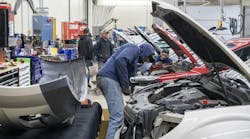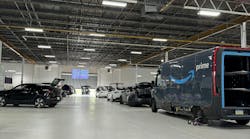New Truckers
driven fad, SUVs and the people who drive them have recently become high-profile media targets. They tend to be more focused on overall traffic flow and on making smooth progress possible for everyone. But where I live, and in the urban areas that my job takes me to, it seems like most of the people driving SUVs are new at it. I have a name for them. Actually I have several names for them, but in print I’ll call them neo-truckers.
It’s easy to spot them. The modern SUV feels more like a car than any truck ever did, almost nimble, so with no prior truck experience, the neo-truckers tend to drive them like cars. It’s their aggressive urban-driving habits that make them obvious, like not looking beyond the bumper in front of them, following too closely, taking possession of the left lane and quick, seemingly unplanned movements with lots of hard braking. Their aggressiveness is made more dangerous by their ignorance. They don’t seem to know that most of the time they’re closer to the edge of the handling envelope than they’ve ever been in a car, and they surely don’t understand or even think about the mass that they’re piloting through heavy traffic. They remind me of my eight-year-old son as he twirls and swings a three-foot plastic bat in the living room, pretending to be a Jedi warrior. He has no awareness of the damage he can do and not nearly enough experience to risk the odds.I don’t expect this to get any better. With all the electronics and automatic features and added distractions being built into today’s cars and SUVs, the typical American driver is gradually being ‘dumbed down.’ Imagine a 19-year-old kid driving a 350 horsepower 3-ton SUV. There will be lots of them as the trucks age and become affordable to the next generation of drivers.I just read a book called “High and Mighty” by Keith Bradsher, a New York Times reporter and Detroit Bureau Chief from 1996 to 2001. His book is an indictment of SUVs, the companies that build them and the regulations that allow them to remain on the road. The subtitle of the book is “SUVs: The world’s most dangerous vehicles and how they got that way.” It explores the trucks’ environmental impact and their impact on society through things like insurance rates, highway congestion and traffic fatalities. My opinions about SUVs and the people who drive them were formed by personal observation before I read Bradsher’s book. I don’t criticize the industry as much as the society that created them, but I can’t deny his book has influenced me and probably other writers, too. Whether it’s being consciously orchestrated or just a media-driven fad, SUVs and the people who drive them have recently become high-profile media targets. If our activities in the Middle East affect the price or availability of gasoline, the media can easily make driving this uniquely American vehicle seem quite unpatriotic.
Actually I think gas mileage is a side issue, but if it means there are fewer trucks, then someday trucks might be driven by real truck drivers again. I can only hope.
Continue Reading
Subscribe to our Newsletters



